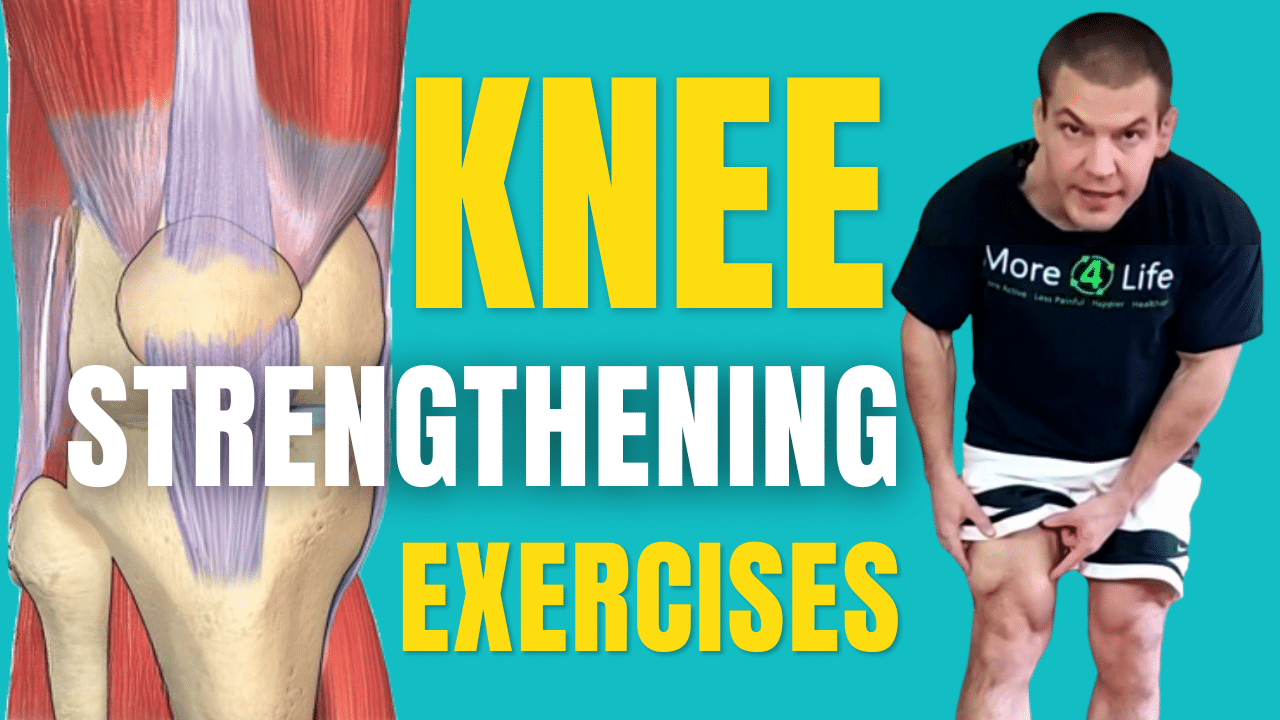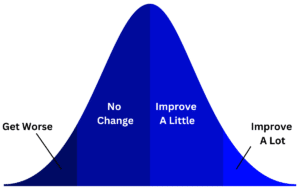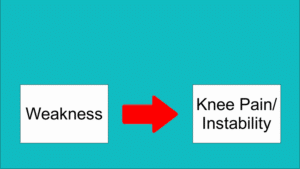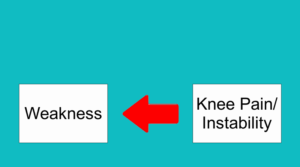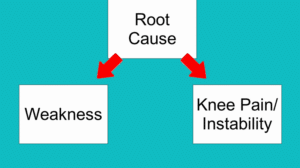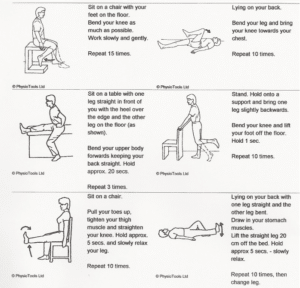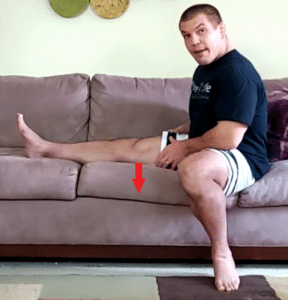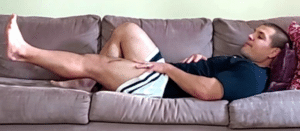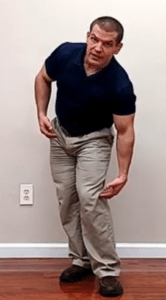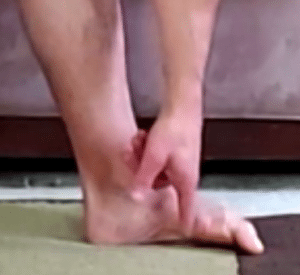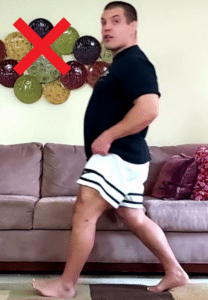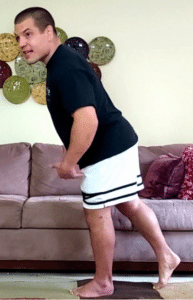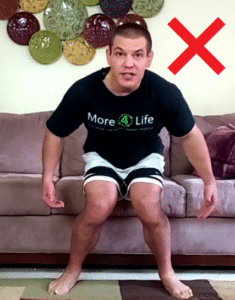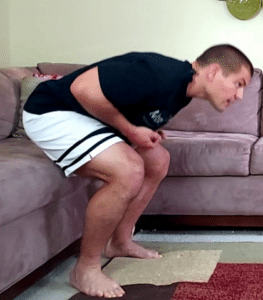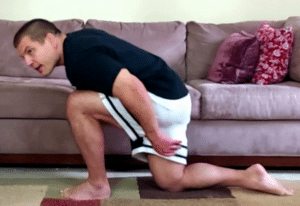Want To Strengthen Your Knee With Exercises At Home?
There are hundreds, if not thousands, of videos on the internet with home exercises to strengthen your knee.
So how do you know which knee strengthening exercises are best for you?
Watch this video to learn why typical knee strengthening exercises don't always work & what to do instead.
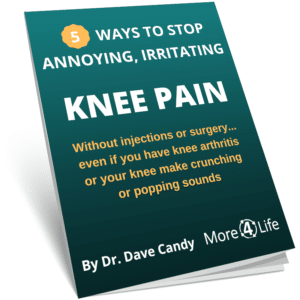
Not Just Another Post About Knee Strengthening Exercises
Really? What makes this post different?
In this post, you'll learn:
- How Is This Blog Post Different?
- Why Do You Want To Strengthen Your Knee In The First Place?
- 2 (often FALSE) Assumptions About Knee Strengthening
- Situations In Which People Get Knee Pain or Instability
- The Problem With "Typical" Home Exercises To Strengthen Your Knee
- 2 Home Exercises To Strengthen Knee After Surgery
- Home Exercises To Strengthen Knee For Walking
- Home Exercises To Strengthen Knee When Standing Up From Sitting
- Home Knee Strengthening Exercises To Stand Up From Floor
- Home Exercises To Strengthen Knee For Going Up And Down Stairs
- Conclusion
How is this post different from typical blog posts about knee strengthening exercise?
Largely, most people treat knee strengthening exercises like they're one thing.
Kind of like if you go to a doctor's office and they reach in a file drawer and pull out a sheet of knee exercises and hand them to you.
...or if you go to a physical therapist's office and they pull out a sheet of home exercises to strengthen your knee.
...or if you go online and print off a knee strengthening exercises PDF.
Those exercises weren't made for you.
Those exercises were made for the "average" person with knee pain.
And generally, when you do a program made for the "average" person, you get average results.
There are a few people who do really, really well.
There are a lot of people in the middle who do just okay.
And there are some people who don't get any benefit or get worse.
The 80 / 20 Rule
The Pareto Principle, otherwise known as the 80 / 20 Rule, states that 80% of your results will come from 20% of your effort.
While it's not precise, that principle applies to most areas of life.
In this case, if you get a sheet of 10 exercises to strengthen your knee, probably only 2 or maybe 3 of those exercises are really, really beneficial.
The other seven or eight are either probably wasting your time without any significant benefit, or they may actually be making you worse.
So, wouldn't it be nice to be able to find just the exercises that help you and to skip the time-wasters and the ones that make you worse?
We think so.
At More 4 Life, we believe in working smarter, not harder.
So in the rest of this post is dedicated to helping you find the exercises that are best for YOUR knee problems so that you can get the most bang for your buck when exercising.
Why Do You Want To Strengthen Your Knee In The First Place?
Intrinsically, people tend to think that having strong muscles or strong joints is a good thing.
Technically, your knee is a joint, not a muscle, so you can't really strengthen your knee.
But most of the time when people talk about "knee strengthening exercises", they're talking about the muscles above and below the knee: your quadriceps, hamstrings, and calf muscles.
And that's what most knee strengthening exercises focus on: the quadriceps, the hamstrings, and the calves.
Why strengthen your knee?
Largely when I hear people say that they want to strengthen their knee, it's for one of two reasons:
- Their knee feels weak or unsteady or unstable, like it might give out or they might fall. Or, they've actually fallen in the past and they want to be able to move around safely without risk of their knee giving out on them.
- They have knee pain, and they think that by strengthening their knee, it'll make the knee pain go away.
2 (often FALSE) Assumptions About Knee Strengthening
There are two really big assumptions in the reasons above that there that may or may not be true.
Assumption #1 - The knee muscles actually NEED to be strengthened
The first assumption is that the muscles around the knee (the quadriceps, hamstrings, and calves), are actually weak to begin with.
Because if they're not weak to begin with and you're still having a problem, it's unlikely that strengthening your knee muscles will fix the problem.
After seeing hundreds or thousands of patients with knee pain and balance problems over the years, I can tell you there's only a small percentage of people who actually have weakness of their quads, hamstrings, or calves
Largely, a lot of people have really strong muscles around their knees.
It's usually the hip, ankle, and/or foot muscles that get weak.
So, first of all, you want to make sure that you actually have knee weakness.
Assumption #2 - Strengtening your knee will fix your knee problem
The second assumption is that if you actually do have knee weakness, that fixing the weakness will fix the instability problem or fix the knee pain.
You have to think about it from a cause and effect relationship. Correlation does not imply causation.
If you happen to have knee weakness and you happen to have instability and/or pain, you're kind of assuming that the weakness was the cause of the instability or the pain.
But it could also be that if you have knee pain, your brain tells you NOT to use your knee muscles. Or you become less active due to the pain and develop weakness as a result.
It's also possible that there's some third factor that's causing both the knee pain/instability AND the knee weakness.
So, if you're treating the knee weakness and it's not really the cause of the knee pain or the knee instability, then you're just treating one symptom to help get rid of the other symptom rather than treating the root cause.
That's what we help people do at More 4 Life... discover the root cause of their pain and how to fix it.
Situations In Which People Get Knee Pain or Instability
So let's consider a couple different common situations in which people have knee pain, knee weakness, and/or knee instability.
Then we'll go over specific exercises to strengthen your knee in each of those situations.
Most people don't actually want knee strengthening exercises.
What they really want are things like being able to:
- Walk without knee pain or without fear of falling.
- Squat down to pick something up off the floor without knee pain.
- Get off of a low chair or couch or a low toilet without having knee pain and without feeling like they really have to push up using their hands.
- Get up and down from the floor, for example, to play with their grandkids or to work out in the garden.
- Go up and down stairs without knee pain and without the risk of falling and injuring themselves.
So, I'll go over some different exercises to strengthen your knee in each of those different situations.
First though, it's good to understand why "typical" knee strengthening exercises don't always help.
The Problem With "Typical" Home Exercises To Strengthen Your Knee
Now, if you've found a knee strengthening exercises PDF online or if you've gotten a sheet of home exercises from a doctor or a physical therapist, you've probably seen something like this:
Typical knee strengthening home exercises include quad sets, straight leg raises, knee extensions, hamstring curls, etc.
These are the most common "knee strengthening exercises" prescribed by doctors and physical therapists.
There's a problem with this kind of knee strengthening exercises though:
They're non-weightbearing, which isn't how you use your knee in real life.
For one, the force needed to lift your leg (even if you use a 5-lb ankle weight) pales in comparison to lifting your entire bodyweight up a stair or up from the floor.
And let's not even talk about athletic activities such as running or jumping.
Furthermore, they're just not functional. Even if you get stronger from doing these type of exercises, your brain doesn't translate this type of strengthening into how to use the muscles in daily activity.
So the BEST home exercises to strengthen your knee are the ones that most directly resemble the movements you do in everyday life.
Now there is a time and a place for these more "traditional" knee strengthening exercises.
Some of those hose situations include:
- If you have a knee fracture and you can't put weight on your knee for a few weeks
- You've recently had a knee surgery and you've got some surgical weightbearing precautions.
- Swelling from knee surgery has inhibited your quad muscles causing them to be weak.
- You have overall body weakness or deconditioning from being sick, immobilized, or sedentary.
2 Home Exercises To Strengthen Knee After Surgery
When you've had surgery, the swelling and other tissue damage from knee surgery can sometimes neurologically inhibit your quadriceps muscles.
Although many patients are focused on gaining back their knee bending (knee flexion) after surgery, regaining the knee straightening (knee extension) is actually the more urgent priority.
Being able to straighten your knee fully makes your knee more stable when walking. Furthermore, if you don't regain knee extension quickly after surgery, it gets much harder to regain down the road.
Quad Set Knee Strengthening Exercise
To do the quad set where, sit with your leg out straight.
Try to tighten your thigh (quadriceps) muscle and push the back of your knee down into the bed.
When you do that is you should actually see a change in the contour of the thigh muscles. You should also see your kneecap move.
You shouldn't just push the back of your knee down using your hamstrings and glutes to extend your hip.
Really focus on squeezing your thigh muscle.
Straight Leg Raise Knee Strengthening Exercise
A straight leg raise is another good post-surgical exercise to strengthen your knee.
Start by lying on your back and doing a quad set to straighten your knee.
Then keep the knee straight as you raise your leg into the air.
Almost think about lifting your heel first and then lifting your knee.
That will help you keep your knee straight the when lifting it.
You don't want what's called a quad lag, where your knee comes up first because then you're not activating your quads.
So, lift the heel first, then lift the knee.
When you can do 10 straight leg raises holding for 10 seconds each, you're probably ready to move on from the non-weight bearing knee exercises and move into weight-bearing exercises.
Home Exercises To Strengthen Knee For Walking
There are largely two different things that cause knee pain or instability when walking.
The first one is a frontal plane or a rotational plane problem.
In this case, you get too much side-to-side motion of the knee or too much twisting in the knee joint.
That twisting and side-to-side motion are actually not controlled by your knee muscles. They're controlled by your hip muscles and the muscles controlling your foot and ankle.
If you're getting too much side-to-side motion, it makes your knee unsteady or unstable.
A good exercise to help with this is just to practice balancing on one leg.
Start by doming your arch.
This will keep your hip, knee, and foot in alignment to make your leg a sturdy pillar.
Then practice standing and balancing on one leg keeping your arch lifted and your pelvis level.
This is good to help make you more steady when walking. Standing on one leg also can help prevent falls.
Furthermore, the ability to stand on one leg for 10 seconds or more has been shown to decrease risk of mortality (death).
The second issue with walking is if you can't get your knee straight.
If you're taking a large step with your foot out in front of you, your knee can potentially buckle if you can't straighten it all the way.
So, you want to be able to get your knee all the way straight when you're walking.
Doing the quad set mentioned above is one good way of doing that. You can also make some changes to the way that you walk.
If you take a really large step and you're pulling forward from your heel, your quads have to be a lot more active in the initial heel contact.
However, if you push off your rear leg and your front foot hits more underneath you, then your body weight is already over the leg.
The knee is a little bit straighter, and you don't have to carry as much of the weight as if you hit with your heel far in front of you.
So hitting with your foot underneath your body rather than hitting with your foot way out in front of your body is another way to improve your knee stability when you're walking.
Home Exercises To Strengthen Knee When Standing Up From Sitting
Now let's talk about squatting and standing up from sitting in a chair.
When you're squatting, there is also a frontal (side-to-side) plane problem and a sagittal (front-to-back) plane problem.
Frontal / Rotational Plane Problem
This happens with your knees go inward when you go to stand up from a chair.
If your knees sort of buckle together like this, you may feel weak and unsteady.
Make sure that you have your hips, knees, and feet equal width apart with knees over toes.
Front-to-Back Plane Problem
Another problem when standing up from sitting is that if your hips are too far behind your feet, it requires a lot of thigh strength to stand up.
To fix this problem, scoot forward in the chair and bring your feet closer to you.
Lean your trunk forward to get your bodyweight over your feet.
Then you can stand up up a whole lot easier just by raising your bottom up and then standing up.
You still have to use your thigh muscles some to stand up, especially if you're deconditioned.
This can be a really good strengthening exercise, just practicing standing up and sitting down for repetitions.
Home Knee Strengthening Exercises To Stand Up From Floor
Now, what about standing up from the ground or getting up from the floor, for example, playing with your grandkids or gardening?
When you're getting up from the floor, you want to first get into a lunge position.
Then lean your trunk forward just like when standing up from a chair.
This will help get your center of gravity over your foot and help you stand up from the floor.
Now, that may be hard for you, especially if you have knee pain.
So you can start by just doing a little mini-lunge.
This is a good exercise strengthen your knee to help you be able to get up and down from the floor with less difficulty, and with less knee pain.
As you get stronger, you can go deeper and deeper down into that motion until you can get all the way up and down from the floor.
Other things to keep in mind when doing a lunge are to keep your weight more on your heel rather than your toes.
Putting your weight on your toes puts a lot more stress on your kneecap and on your patellar tendon.
If you keep the weight relatively more on your heel, that uses more of your hip muscles or your glute muscles.
So that's the lunge exercise to help you get up from the floor without knee pain.
Home Exercises To Strengthen Knee For Going Up And Down Stairs
Finally, what about going up and down stairs?
When you're going up and down stairs, you're on one leg, and so you want to first be able to just do that standing balance exercise that I mentioned earlier.
Stand on one leg and keeping your pelvis level.
Once you can do that, progress to doing a little mini-squat on one leg where you have one leg in front of you.
This would really more simulate going down the stairs where you're reaching out with the front leg and you're squatting with the back leg.
If you put your non-weightbearing leg behind you, that simulates going up the stairs.
In this case, you're pushing up with your front foot.
Now, similarly to the other exercises, you want to make sure that your hip, knee, and toe stay in good alignment when doing the single leg squat.
You also want to put the weight more through your heel.
So, when you are going up the stair, you want to try to get as much of your foot on the stair as possible so you can push more through the heel rather than the toes.
That will help get your glutes activated so that you don't use excessive force out from your quadriceps. Excessive use of the quadriceps can put excessive compression on your kneecap causing patellofemoral pain. It can also put stress on your patellar tendon.
Read this post more tips on how to stop knee pain going up and down stairs.
Conclusion
So those were some ways to strengthen your knee with exercises at home.
As mentioned previously though, there's much more than knee weakness that contributes to knee pain.
For example, flexibility problems in your quadriceps, hamstrings, or calves are often bigger contributors than weakness in these muscles.
Furthermore, improper movement patterns during the activities that you do everyday are often the biggest contributors to knee pain on instability.
As we often tell our patients:
"It's not the exercises you do 1 hour per day... it's what you do the other 23 hours per day when you're NOT exercising that makes the biggest difference."
Need Help For Knee Pain, Weakness, or Instability?
Tap the button below to request an appointment with one of our specialists.

